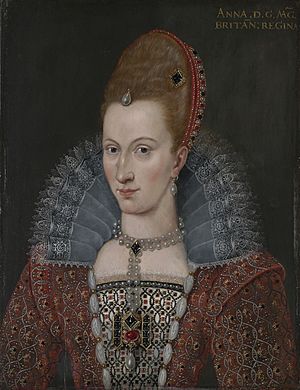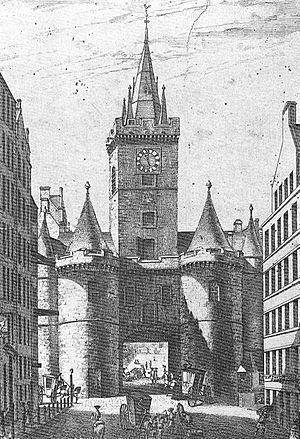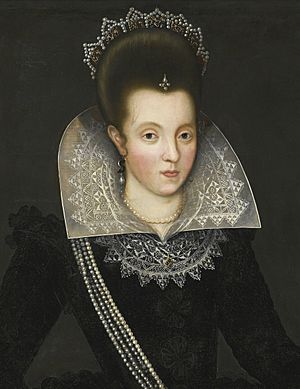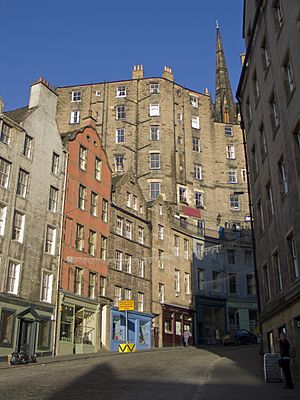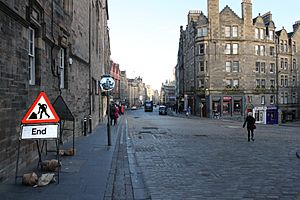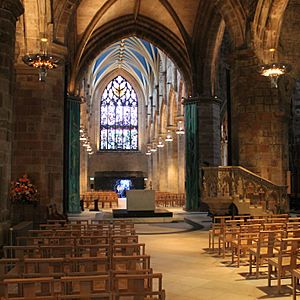Entry and coronation of Anne of Denmark facts for kids
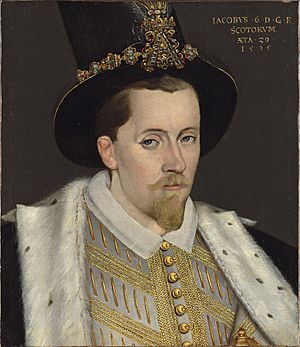
On 17 May 1590, Anne of Denmark became the Queen of Scotland in a special ceremony. Two days later, on 19 May, she made a grand entrance into Edinburgh. This event was a huge celebration with lots of shows, plays, and artistic displays. These events were designed to show off the city and the country, much like similar celebrations in other European cities. Anne of Denmark was supposed to arrive in Scotland in September 1589, but bad weather and other problems delayed her. King James VI of Scotland eventually sailed to Norway to meet her in November. They both returned to Scotland in May 1590.
Contents
Planning the Queen's Arrival (1589)
In August 1589, King James VI announced that his marriage plans were complete. His bride, Anne of Denmark, was expected to arrive soon with many important Danish guests. The King asked Scottish towns to help pay for the celebrations. He wanted £20,000 Scots to entertain the new Queen and her group.
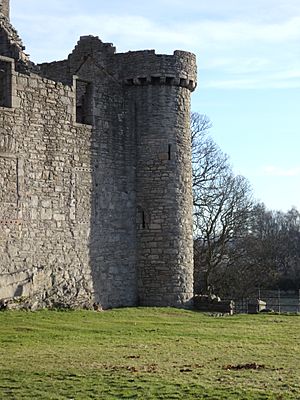
In September and October 1589, James VI waited for Anne at Seton Palace and Craigmillar Castle. He decided to sail to Norway after receiving letters from Anne. Edinburgh town and the royal household made many preparations for the Queen's arrival. They ordered fancy saddles and costumes for her helpers.
King James also asked his nobles to send food from their estates for Anne's welcome. This included "fat beef, mutton, wild fowls and venison." He also asked for riding horses for himself and the Queen. The Privy Council of Scotland ordered that gunpowder be saved for fireworks and cannon salutes during the celebrations.
The town council fixed the East Port, also known as the Netherbow Gate. This gate is on the Royal Mile and leads to Holyroodhouse. Workers painted the stone walls to look like marble and added gold decorations. Other artists painted props and costumes. Wooden platforms were built for the shows. Townspeople were asked to lend their best table linens for the Danish visitors. A velvet canopy for the Queen and special books were also prepared.
Similar royal welcomes had happened before. King James VI had one in 1579 when he left Stirling Castle. His mother, Mary, Queen of Scots, also had a grand entry in 1561. For Mary's entry, stages were built and painted. Town officials wore fancy black velvet cloaks and crimson jackets. Young townsmen in taffeta costumes joined the parade.
Queen Elizabeth I of England even planned a special show for her ambassador to present to Anne. This show would have included six dancers dressed as warriors and masked torch bearers. The costumes were made in the Stewart family colors of red and yellow.
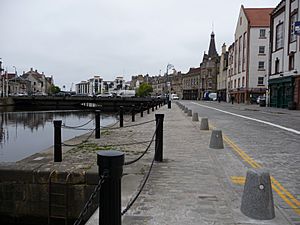
In September, the English ambassador in Edinburgh, William Ashby, noted the "great preparation" in Leith for the Queen. This included a covered walkway from the docks to the King's Wark. There was also a temporary wooden staircase and platform leading to the Queen's Lodging. These structures were covered with fancy carpets and tapestries. Cannons were brought from Stirling Castle and Tantallon Castle for salutes.
The welcome speeches were carefully planned. Important Scottish lords and tutors would greet Anne on her ship in Latin. On the Shore of Leith, she would be met by noble Scottish ladies. Another speech would be given on a platform at the King's Wark. Anne was planned to stay in Leith for 12 days before her grand entry and coronation.
In September 1589, a large silver collection was brought from England for the Queen's banquet. This silver and other goods were worth £2,000. King James later gave some of these items as gifts to nobles he met in Denmark and Norway.
Food gifts were also sent from northern England. The Earl of Derby sent "a brace of fat stags baked in the English fashion." Clothes for the wedding were bought in London. King James also asked for actors from English theater groups to perform in Edinburgh.
The Queen's Delayed Journey
Anne of Denmark set sail on 5 September 1589 with 18 ships. The fleet included ships like the Gideon, Josaphad, and Samson. One ship, the Gideon, started leaking. Two other ships were separated from the fleet by a storm.
News of the storm and the Queen's danger reached Scotland. While waiting, King James VI may have started writing love poems. He decided to go to Norway himself after Anne wrote to him. She explained that bad winds had forced her ships back to port several times. She wrote that "Winter is hastening down on us," and they had to delay the trip until spring.
Anne's mother and brother sent similar letters. But James had already made up his mind. Because of the "sundrie contrarious windis" (many contrary winds), James asked East coast sailors to come to Leith. He sailed with six hired ships on 22 October, heading for Flekkerøy near Oslo. He landed on 3 November and slept in the same farmhouse Anne had used.
James VI met Anne in Oslo and married her on 23 November 1589. He wore fancy red and blue outfits. After visiting Anne's family, they traveled to Denmark to join the Danish royal court. James enjoyed himself, playing cards and a dice game called "Mumchance." They also attended the wedding of Anne's sister, Elisabeth, in April 1590. James later wrote poems about his journey and the winter weather.
Many people blamed the storms on witchcraft. One woman accused in the North Berwick Witch Trials, Agnes Sampson, said the King's ship had a "contrary wind" while other ships had good winds. This was seen as very strange. When James VI first sailed for Norway, his ship was indeed driven back to St Monans in Fife.
The idea that witches caused the storms appeared in a play at the baptism of Prince Henry in 1594. A ship in the Great Hall of Stirling Castle showed their good fortune.
Getting Ready for Their Return
King James VI sent instructions for his welcome with William Schaw, who was to fix up the Palace of Holyroodhouse. Schaw received £1000 for the palace repairs.
James also ordered five ships for the return trip to Scotland. These ships were to be decorated with flags and streamers of red and yellow. They were to be ready by 1 April 1590. The flags for one ship alone cost over £500.
From Denmark, James VI sent a list of who should welcome them at Leith. He also listed the food and drink needed for his Danish guests. He wrote to his council, urging them to keep things in order and prepare well. He said, "a King of Scotland with a newe married Wife will not come hame every daye" (a King of Scotland with a new wife won't come home every day). He wanted them to respect his honor and the honor of the whole nation.
James also ordered 200 soldiers to attend his landing and keep crowds away. This disappointed some nobles who feared their rights might be ignored. Fireworks were planned, and a sugar expert was to prepare sweets for banquets. Noble ladies were to organize a welcoming party.
Arrival at Leith
Anne of Denmark and James VI arrived at Leith on 1 May 1590. James gave gold coins to the ship's captain, pilots, and musicians. Anne was welcomed with speeches at her lodging in the King's Wark, where she stayed for five days. A large bonfire was lit that night on Salisbury Crags.
They left Leith for Edinburgh on 6 May 1590, riding in a procession up Easter Road. The King rode first with his earls. The Queen followed in a coach shipped from Denmark. This coach was very eye-catching, described as "richly apparelled with cloth of gold and purple velvet," and said to be all silver with "no iron in it."
A coronation at Holyrood Abbey and a grand "Entry" into Edinburgh were planned. The dates were swapped so the celebrations wouldn't fall on a Sunday.
The Danish ambassadors wanted to see the lands and palaces given to Anne by James as a "morning gift" (a gift from a husband to his wife the morning after their wedding). They visited Wemyss Castle, Falkland Palace, Linlithgow Palace, and Dunfermline Palace. The English ambassador heard that the Danes were not happy with the value of the lands or the condition of the buildings. They wanted Anne to have as good a settlement as Margaret Tudor received in 1503.
The Coronation
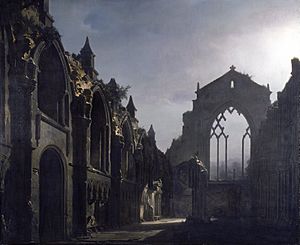
The Coronation took place on Sunday, 17 May 1590, in Holyrood Abbey. Fifteen men were made knights before the ceremony. Robert Bruce was the minister. Important lords carried the sword of state, the scepter, and the King's crown.
James VI entered the church with five earls holding his purple cloak. John Maitland carried the Queen's crown. Anne followed, with the English ambassador on her right and the Danish admiral on her left. Several Scottish countesses held the Queen's long dress. Other noblewomen and maids of honor followed. After everyone was seated, psalms were sung, and a sermon was given.
Robert Bruce explained that the anointing (a special blessing with oil) and other rituals were civil, not religious. A countess helped Anne adjust her clothing to expose her shoulder, and Bruce anointed her with oil. Some church ministers thought this anointing was wrong. The Queen then changed into royal robes behind a curtain in the church. Her robe was made of purple velvet with white taffeta lining and gold decorations.
After changing, she returned to her seat, and Bruce placed the crown on her head. James passed the scepter to Bruce, who gave it to the Queen. Bruce welcomed her as "our most gracious lady and queen of Scotland" in Scots. Another minister repeated the speech in French, which Anne understood better. She read her oath, promising to support God's work, justice, and the church. The crowd cheered, "May Our Lord and God protect and keep the queen!" Anne then moved to a higher throne. A Latin poem was recited, and Bruce spoke about the benefits of the marriage. An oath to serve the Queen was made on behalf of the Scottish people.
The Queen's Crown
The Queen's crown was described in later lists of royal jewels. It was an imperial crown with arches, topped by a ball with pearls and a cross with diamonds, pearls, and a ruby. The main stones on the band were a large sapphire, a diamond, and a ruby, with 24 pearls. The crown had a purple velvet cap inside. This might have been a crown made for Mary of Guise, the mother of Mary, Queen of Scots, in 1539.
Entry to Edinburgh
West Port Welcome
The grand "Entry" into Edinburgh happened on Tuesday, 19 May 1590. The Queen entered the town at the West Port, a gate on the west side of Edinburgh. A lawyer gave a speech in Latin. The gate was decorated with tapestries, and musicians played from a platform above. A globe was lowered to the Queen's coach. It opened to show a boy dressed in red velvet. He gave the Queen a Bible, a key to the city, and a jewel, while reciting a poem. The globe then closed and was pulled back up. The boy represented "Edina," the spirit of Edinburgh. The Bible was bound in fancy leather, and two silver keys were made by a goldsmith.
The Convoy of the Moors
As part of the ceremony, about fifty people walked in front of Anne's coach to clear a path through the crowds. Some wore masks or had their faces and arms blackened. They wore black boots with white leggings. These were young men from Edinburgh representing African people, called "Moors" at the time. The leader was an African man holding a sword, and his followers had long white staffs. Some wore sailor-like tunics and gold necklaces, with gold decorations at their noses and ears. They walked in a special way, sometimes stiffly, sometimes half-dancing.
A poet named John Burell wrote about the "Moirs" and their precious stones. He said these men represented people from "the Inds" (the Indies) who lived in comfort and came to honor the Queen.
A similar performance had happened during Mary, Queen of Scots's entry into Edinburgh in 1561. An African man was also part of Anne of Denmark's household later in 1590. Some historians believe he was the same person who led the "Moors" in the Entry.
The Horoscope
Anne's coach moved under a canopy up the narrow street called the West Bow. There, a boy with mathematical instruments played the role of Astronomy. He recited Latin verses about Anne's future and the children she would have. He predicted a hailstorm, and white sugar sweets were thrown from nearby windows. The child said this "rain" would fall into her lap, proving his prediction. The sweets cost £3-2s-8d Scots. Anne's canopy was carried by six men, mostly merchants.
The Muses' Song
At the top of the street, where the "Butter Tron" (a weigh house) was, nine young women from Edinburgh dressed as the Muses. They wore fancy costumes and held gilded books. They curtsied and sang, but did not speak. Instead, another schoolboy spoke for them in verse. He explained that the muses served the King, and Anne would be their refuge and mother.
The Virtues' Advice
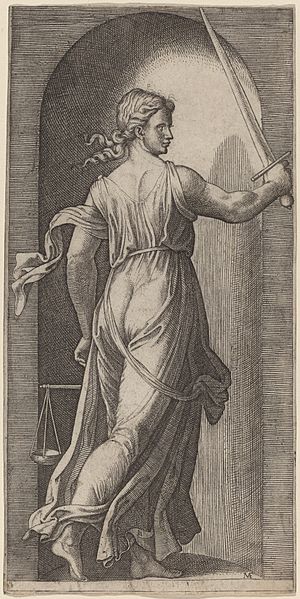
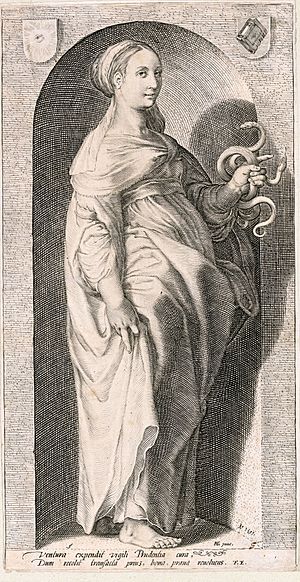
Outside St Giles Kirk, a large stage was set up. On it stood Mother Virtue (or Piety), crowned, with her four daughters. The daughters were dressed in black silk with flower crowns. Virtue took off her crown and gave it to the Queen. Virtue's speech encouraged Anne to welcome her daughters: Prudence, Justice, Fortitude, and Temperance. Each daughter then came forward. Prudence, with an astrolabe, warned against laziness. Justice, with her sword and scales, said strong castles are built on fairness. Fortitude, with a club and shield, advised humility in success. Temperance, with an hourglass, advised self-control. Mother Virtue concluded that God's Word was the greatest wealth. Then Psalm 120 was sung.
The five actors were young men dressed as women.
A Feast and Family Tree
Anne of Denmark got out of her coach and walked into St Giles under a red velvet canopy. A choir sang Psalm 19. Robert Bruce preached about Psalm 107, giving thanks for the safe return of sailors. Then Psalm 23 was sung. Outside the church, a show featured the ancestors of Danish kings and the coats of arms of previous Scottish queens. Nearby, schoolboys playing Bacchus (god of wine) and Ceres (goddess of agriculture) offered a banquet. This symbolized the richness of the lands given to the Queen. A large actor, sitting on a wine barrel, threw food gifts into the crowd.
At the "Salt Tron" (where salt was weighed), an artificial tree had five levels with boys representing kings and queens. They displayed the coats of arms of Denmark and Scotland. At the base of the tree was Christian I of Denmark, a common ancestor of James VI and Anne. A boy explained Anne's family tree, highlighting the marriage of Margaret of Denmark to James III of Scotland in 1469.
Solomon and the Queen of Sheba
The final show of the Entry was at the East Port or Netherbow Gate. A play between Solomon and the Queen of Sheba was performed. The Queen said she came to Solomon to learn from his wisdom. She brought him a special plant that doesn't grow in Scotland. Solomon replied that she would always be honored. Another schoolboy then explained to Anne that just as the Queen of Sheba wanted to meet Solomon, James had traveled to meet her. He said all Scotland would now serve her. He gave Anne a jewel, which was lowered from the Netherbow with a silk ribbon.
Anne returned to Holyroodhouse, still accompanied by the young men dressed as "moors." They tied bronze bells to their legs and began to dance, unlike their slow walk earlier.
After supper at Holyrood Palace, James and Anne watched a sword dance by the light of bonfires. Seventeen dancers wore bells and new Highland clothes.
The Royal Jewel
The town of Edinburgh had a royal jewel as security for a loan to the King in 1584. It was a locket with a diamond and an emerald. In October 1589, the Provost (a city leader) cancelled the loan and gave the jewel back to the King as a wedding gift. The jewel was remade and enlarged by a goldsmith to be presented to the Queen. Some records suggest the jewel was called the "A," possibly referring to a crowned initial on its case. Accounts for making the jewel, its case, the books, and other items are still in the Edinburgh City Archives.
Banquet for Danish Guests
On 23 May 1590, the town held a banquet for the Danish ambassadors at the Mint. Musicians and a guard of honor were arranged.
On 24 May, the King gave a speech in St Giles, thanking the people of Edinburgh for their hospitality. On 26 May, the Danish guests left on their ships. The King gave them gold chains and gifts worth 4,500 crowns. James VI and Anne rode on the sands of Leith to see the ships.
English Ambassador's Visit
On 13 June 1590, Edward Somerset, 4th Earl of Worcester traveled to Edinburgh. He came to congratulate James VI on his safe return and marriage. He also told James that he would join the Order of the Garter (a special English knighthood). At first, he couldn't see Anne because she had a toothache. He joked that in England, this would mean she was pregnant! Worcester met Anne on 16 June and gave her gifts from Queen Elizabeth, including a diamond cloak, a clock, and a pearl necklace. James VI gave the Earl a ring with seven diamonds.
Anne of Denmark and her Danish guests stayed at Holyrood Palace until 18 July 1590. Then she moved to Dunfermline Palace and visited Falkland Palace.
Other Royal Entries
Anne of Denmark also made a grand "Entry" into Perth on 29 June 1591. There are not many records of this event. In December 1592, Anne herself performed in a play at Holyrood Palace to celebrate her birthday.
Plans were made for her to have entries in Dundee and St Andrews in September 1595. She made her first Entry to Dundee on 13 September 1597.
The Danish Party
Many Danish gentlemen came to Edinburgh for the celebrations. These included important advisors like Admiral Peder Munk and Steen Brahe. There were also ship officers like Peder Munk, the admiral of the Gideon, and Henrik Gyldenstierne, the vice-admiral.
Several of these men, along with Scottish partners, rode in front of the Queen's coach during her Entry into Edinburgh on 19 May.
Records and Publications
Several writings from that time describe these events. Much of the information comes from a Danish account, which was published later in 1852. Some poems in Scots and Latin were also printed. John Burrell's poem was part of a book printed by Robert Waldegrave. Waldegrave also printed a Latin work by Adrian Damman, a diplomat from the Netherlands.
Hercules Rollock, the schoolmaster of Edinburgh High School, wrote the verses about astrology and good fortune. His students acted in the shows. He had also published a poem about the marriage in 1589.
The father of the boy who gave the keys to Anne at the West Port was the lawyer John Russell. He wrote a speech for the Queen on behalf of Edinburgh, which was likely the one given at the West Port.
A Scottish story inspired a version printed in London. It was called The ioyfull receiuing of Iames the sixt... (The joyful receiving of James the sixth...) and described the events in Leith and Edinburgh.
Another poem about the marriage was printed in Copenhagen. The National Library of Scotland has a handwritten copy of this poem.
Later, the poet Alexander Montgomerie wrote a poem about two brothers, John and Patrick Schaw. He mentioned their help in advising the King to sail to Denmark.
|


